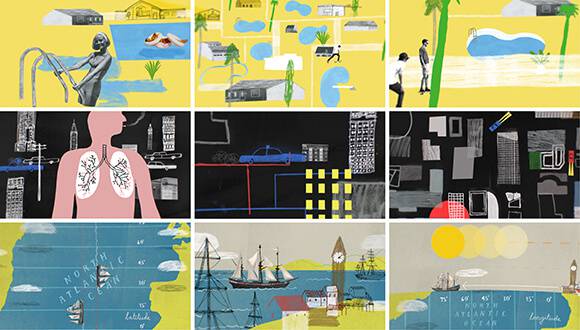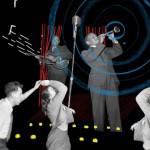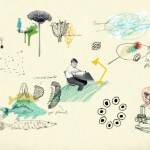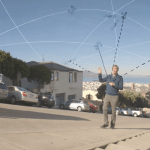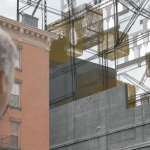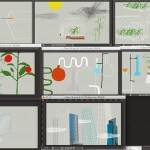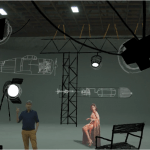Peepshow Collective Scoop First Ever ‘Motion Design’ Emmy Award – Interview
This is a big year for the Motion Design industry, as the Emmy’s have a brand new category to honour it. The awards were held on Saturday, and the first ever winners of ‘Outstanding Motion Design’ are the London-based Peepshow Collective for their work on the landmark documentary series How We Got to Now.
Many may find the result surprising, given that the aesthetic of the winner is decidedly un-Hollywood. Gloriously free from gloss, hand drawn and – dare I say it – lo-fi.
The series is a six-part documentary charting the big ideas of human evolution, presented by and based on the work of Steven Johnson, was a joint venture by US and UK public broadcasters, BBC and PBS. The scale of such a co-production allowed producers Nutopia to approach the commissioning of the motion design with an ambition not normally found in factual series.
The result is as stunning as it is epic. An endless flow of hand drawn illustration and animation that weaves effortlessly through the footage, be it ancient film archive or freshly shot HD. The commentary is reflected in idiosyncratic doodles that appear around the host’s head and are perfectly complimented by collaged photos and hand written text. On their own, these are often used and unsurprising techniques, but the uncompromising way in which they have been treated lifts this series to new heights, with a cohesion that would suggest one single talented illustrator was at the helm.
…And that would be because that’s exactly what happened. The motion design across the entire series comes from the very unique hand of renowned illustrator Luke Best, whose bold aesthetic, complimented by sensitive animation by a small team of animators, is the secret to the show’s success.
To understand how Luke came to be the sole illustrator on such a major project, I asked Peter Mellor, the driving force of animation at Peepshow since the very beginning.
As a collective, Peepshow has a impressive range of illustrators, many of whom often collaborate to produce the artwork on such big projects. How did it end up that Luke’s work took centre stage?
Pete: From the start, Nutopia were looking for one illustrator with a unique strong voice to bring a clear vision to the whole series. Almost as an extension of the presenter. At Peepshow, we’re used to illustrators leading the design, but across the industry it’s quite common for Post-houses to affect a style they’ve seen else where, which of course has less heart. At the time of pitching, Luke’s work just seemed to suite the content so perfectly, and Nutopia were very excited about his involvement.
The credit for of how well Luke’s work came to life across the series falls at the feet of Pete Mellor, who was Animation Director (meaning he gets his own Emmy!!!). Pete’s a very tallented director and a highly skilled animator, but it’s his familiarity of working with Lukes illustration that was so crucial, the result of 10 years working together. As well as animating a large portion of the series himself, Pete also lead a small team of animators who worked on this epic production, guiding all their approaches to reflect Luke’s illustration with one clear voice.
Pete: I enjoyed watching animators with a the smoother motion graphics approach deal with Luke’s lo-fi illustrations. They’d get some artwork where a person’s arms or legs are just missing, and have to accept that’s how Luke wanted it to look. It would make anyone approach the animation differently.
How would you describe the production line?
Pete: This was no different to what we’re used to at Peepshow… Luke would pass us his artwork from Photoshop, which we’d then prepare as we’d need (some of Lukes files needing more TLC than others!). Then the animation was created mainly in After Effects, with moments of Cinema 4D. The key to animating Luke’s work is in discussion to enable us to be clear on the storytelling, so it was crucial that we were all in the same studio with constant interaction.
What do you think you brought to this broadcast project as an Illustrator?
Luke: I’m used to problem solving, it’s what I do in my illustration all the time, so for me that was how I’d approach a huge scene of animation. For the production team at Nutopia, this was something they really valued, that we could get stuck in and suggest the right visual content from an early script stage.
Knowing that you have a history of animating yourself, I wondered how it felt to watch your work brought to life on such a huge scale. And of course, wether you now have any desire to delve back into After Effects or any another animation approach?
Luke: To be honest, over the 9 month project I had too much drawing and thinking to do to take it all in. Now I watch and the animation and of course it’s epic to behold, but as cliched as it sounds, the process of making it is just a blur. But after a little time off, I was really hungering for some animation again, in a way I’ve not had for many years. I do love getting stuck in with animation myself but now I’m keen to expand my animation skills and understanding so I can become a better director. So yeah, more animation is most definitely on the cards…
The fact this series has won the Emmy is exciting for Peepshow, and reflects well on London too, but there’s a broader reason why this international acknowledgement is important. This project is not only an example of why to select a great illustrator to lead the creative process, but it’s also a great lesson in matching the illustration with the right animation approach. Seems obvious right, to reflect the attitude of the artwork in the way its brought to life. Too often though this is handled badly, with an ace animator applying their very slick style to images that just don’t match. As a lecturer, I’ve tried to teach this ideal to illustration and animation students, and with this high profile Emmy win, I have an exciting example to point them to. It’s a project I’m sure we all can take a lesson from.


